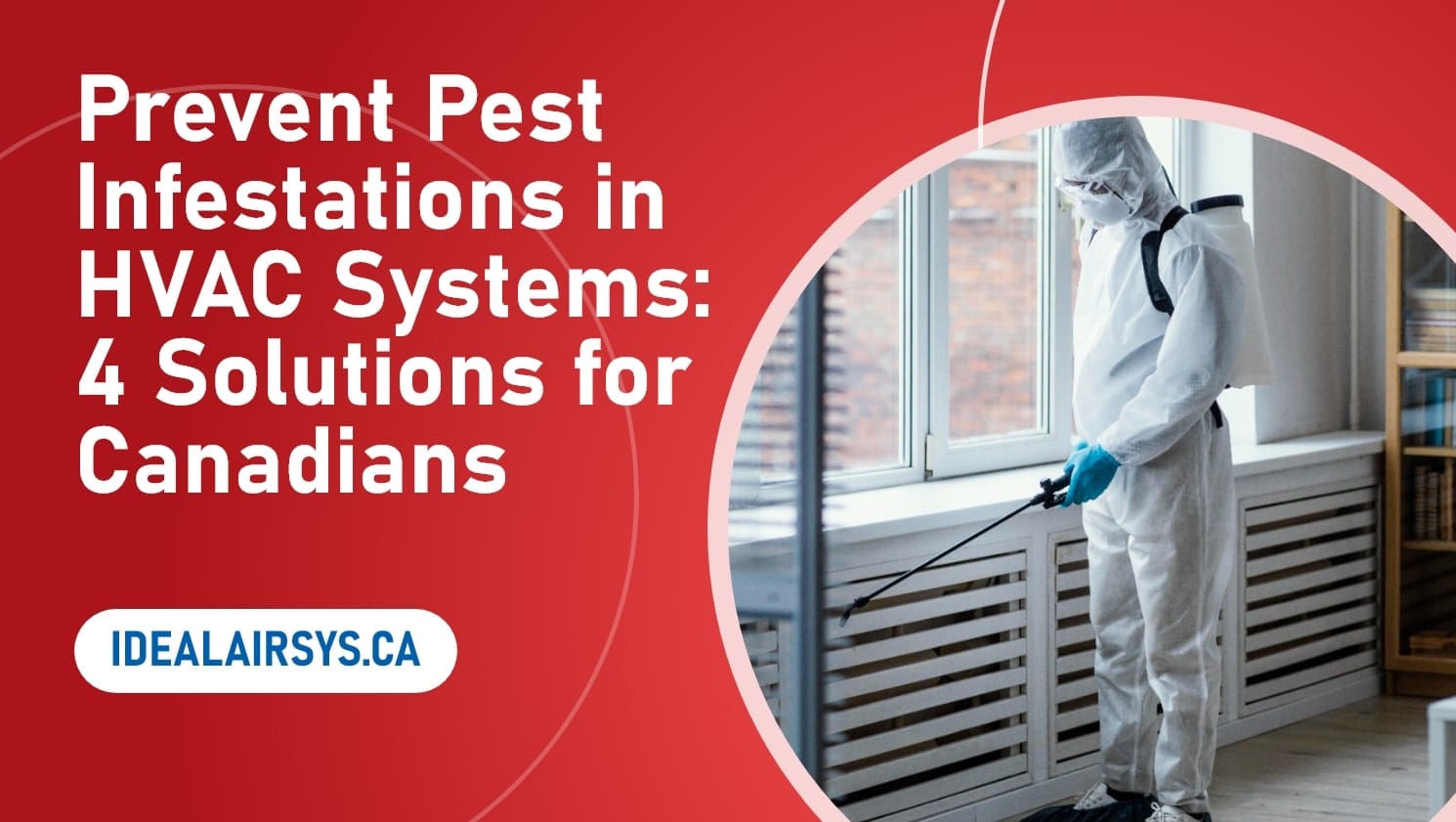
Pest infestations in HVAC systems are a hidden danger for many Canadian homeowners. These unwelcome intruders can significantly disrupt your living environment by compromising your comfort, causing extensive damage to your HVAC system, and posing serious health risks. From clogged ducts to contaminated air, the consequences can be severe if left unaddressed. Preventing pests is not just about protecting your HVAC system but also about ensuring your family’s health and safety.
In this guide, we will:
- Explore the issue of pest infestations in HVAC systems.
- Highlight the main reasons to prevent pests.
- Share simple, actionable solutions tailored for Ontario homeowners.
Read on to discover expert tips to protect your HVAC system and your family from unwanted pests effectively and affordably. Also you can list the a brief interview based podcast about this article below:
Table of Contents
Understanding the Problem: How Pests Impact Your HVAC System
What Causes Pest Infestations in HVAC Systems?
Pests invade HVAC systems primarily to seek shelter, food, and warmth—all of which these systems can inadvertently provide. Openings around ducts, vents, and foundations often act as gateways for these intruders. The problem becomes more severe during seasonal changes, such as colder months, when pests actively seek warm hiding places. Unfortunately, their presence can lead to clogged ducts, chewed wiring, and contaminated air, ultimately reducing system efficiency and creating health hazards.
Common Pests Found in Canadian HVAC Systems
Here are the most common pests that infiltrate HVAC systems and the problems they cause:
- Rodents (Mice and Rats): Rodents are notorious for chewing through ductwork and electrical wiring. This not only creates potential fire hazards but also leads to costly repairs and system malfunctions.
- Birds and Bats: These animals often nest in vents, obstructing airflow, which can drastically reduce system efficiency and potentially lead to overheating.
- Cockroaches and Ants: These insects can clog filters and ducts, leading to degraded air quality and a significant reduction in HVAC performance.
- Insects Attracted to Electromagnetic Fields: Bugs such as ants can be drawn to HVAC wiring and components, potentially causing short circuits and equipment failure.
- Structural Pests: Larger pests can chew through HVAC parts, cause structural damage, and contaminate water systems.
- Pests Spreading Diseases: Many pests, including rodents and insects, can introduce harmful allergens and pathogens into your home’s air, posing serious health risks to your family.
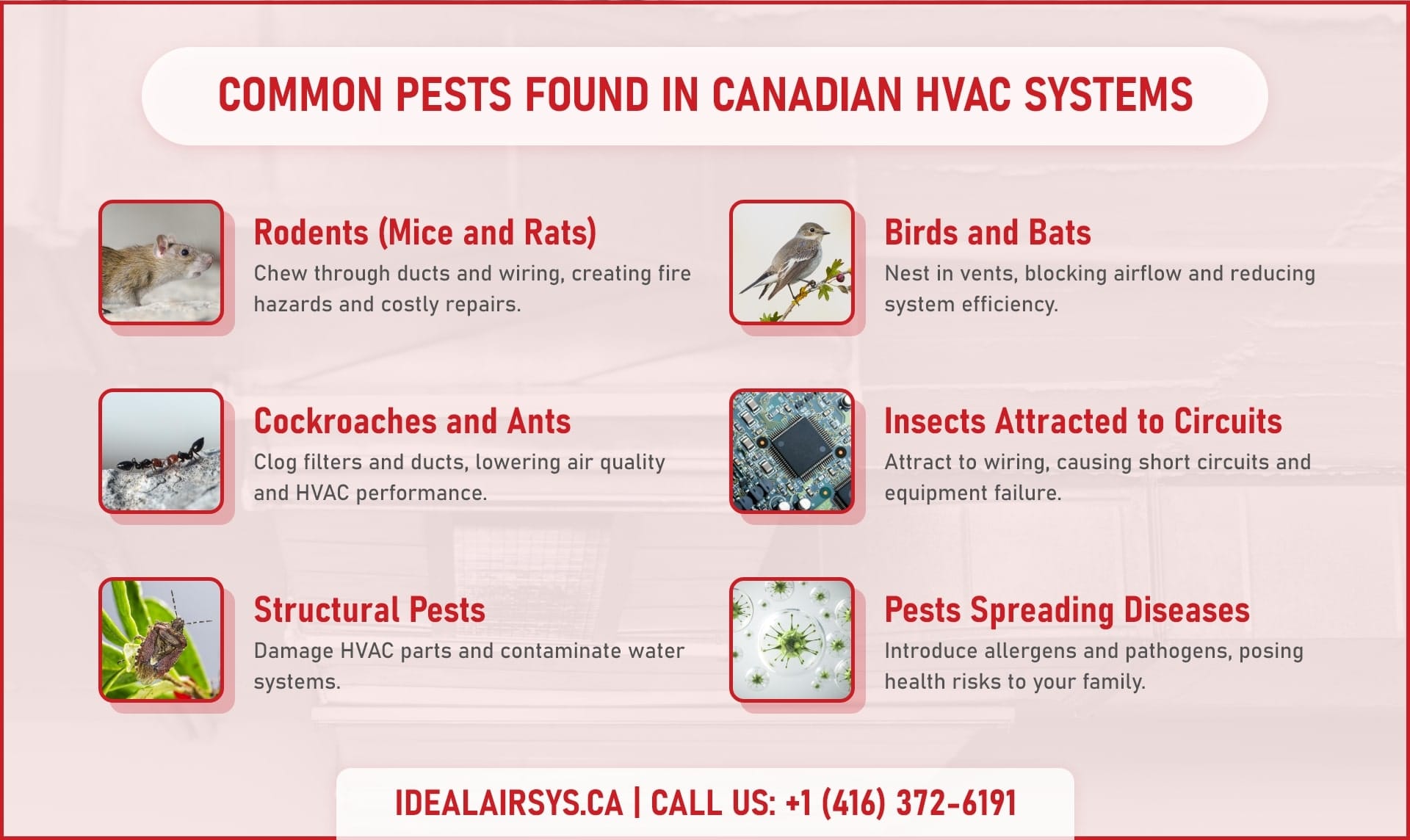
Seasonal Pest Behavior
Pest activity in Ontario changes with the seasons. Rodents are particularly active in winter when they seek warmth and shelter indoors. Insects and birds, on the other hand, become more prevalent during spring and summer. Recognizing these patterns can help homeowners take timely preventive measures to protect their HVAC systems.
The Risks to Your Comfort and Health: Why You Can’t Ignore Pest Infestations in Your HVAC System
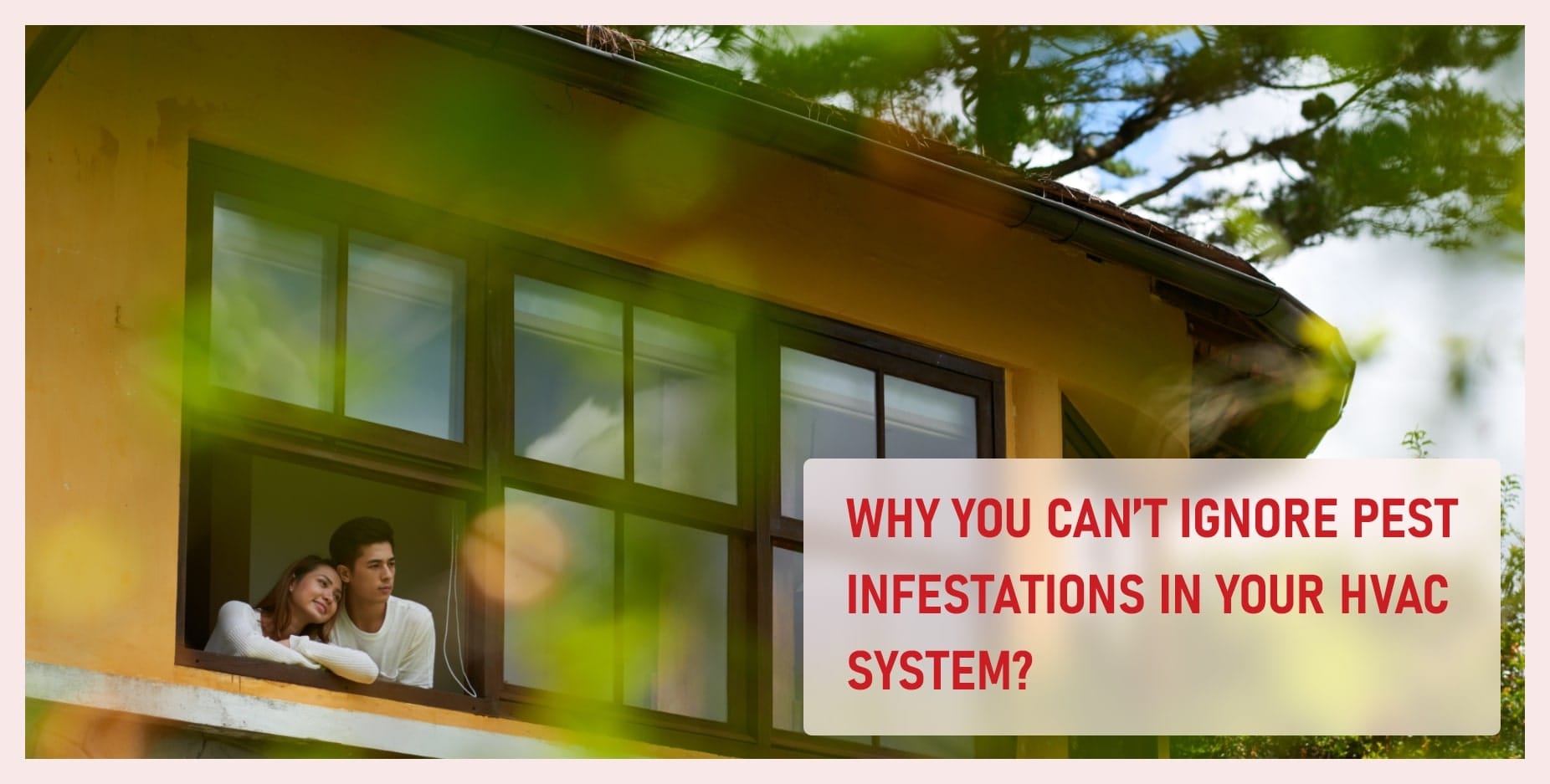
Pests in your HVAC system are more than just an inconvenience—they can severely impact your home’s comfort, efficiency, and the health of your family. If left unchecked, these unwelcome intruders can create hidden dangers that disrupt your daily life and result in costly repairs. Here’s a closer look at the specific risks pests pose to your comfort and well-being.
A. Compromised Indoor Air Quality
Your HVAC system is designed to provide clean, filtered air for your home. However, when pests invade, they leave behind droppings, dander, and other debris that can contaminate the air circulating through your system. Over time, this can lead to:
- Worsened Allergies and Respiratory Issues: Dust mites, rodent droppings, and insect particles can aggravate conditions like asthma and allergies, especially in children and the elderly.
- Health Hazards from Pathogens: Rodents and insects often carry harmful bacteria, viruses, and allergens that compromise your indoor air quality.
A healthy home starts with clean air. Preventing pests ensures your HVAC system delivers the fresh, pure air your family deserves.
B. Increased Energy Costs
Pests nesting in your HVAC system can obstruct airflow by clogging ducts, filters, and vents with debris. This forces your system to work harder to maintain the desired temperature, leading to:
- Higher Energy Bills: An overworked system consumes more energy, driving up your monthly utility costs.
- Reduced Efficiency: When components are blocked or damaged by pests, your system struggles to function, causing uneven heating or cooling and unnecessary strain on critical parts.
By eliminating pests, you can maintain peak energy efficiency and keep your bills under control.
C. Damage to HVAC Components
Pests don’t just invade—they destroy. From chewing wires to building nests in ducts, their activities can result in severe damage to your HVAC system, including:
- Electrical Hazards: Rodents often gnaw on electrical wiring, increasing the risk of short circuits and even fires.
- Costly Repairs: Damaged ductwork, broken components, and compromised insulation all lead to significant repair expenses.
- Premature System Failure: Persistent infestations can reduce the lifespan of your HVAC system, requiring premature replacement.
Taking proactive steps to prevent pests can save you from expensive repairs and ensure your system lasts for years to come.
D. Unpleasant Odors and Noise
One of the first signs of a pest infestation is often the presence of foul smells or strange noises coming from your HVAC system. Common issues include:
- Decomposing Pests: Dead animals in ducts or vents emit foul odors that can spread throughout your home.
- Nesting Materials and Droppings: Accumulated waste can cause persistent bad smells that are hard to remove.
- Disruptive Sounds: Scratching, scurrying, or chirping noises in your ductwork can disturb your peace of mind, particularly at night.
A pest-free HVAC system ensures your home remains a sanctuary of comfort and tranquility.
E. Health and Safety Risks
Beyond discomfort and inconvenience, pests pose genuine health and safety threats, such as:
- Fire Hazards: Damaged wiring from rodents can lead to electrical fires, putting your family’s safety at risk.
- Spread of Diseases: Pests like rodents, cockroaches, and ants carry diseases that can infect your family through contaminated air.
- Structural Damage: Larger pests can damage insulation, walls, and other structural components, compromising the integrity of your home.
By addressing pest issues proactively, you protect your home and family from these potentially devastating risks.
Signs of Pest Infestation in HVAC Systems: Know the Warning Signs Before It’s Too Late
Pests in your HVAC system can wreak havoc on your home’s comfort, air quality, and overall efficiency. Spotting the signs early can save you from costly repairs, health risks, and unnecessary stress. Here’s what to watch for to ensure your HVAC system remains pest-free and fully functional.
A. Unusual Noises
Hearing strange sounds from your HVAC system is often the first indication of a pest infestation. Listen for:
- Scratching or Scurrying: Rodents or small animals moving through ducts or vents.
- Chirping or Flapping: Birds or bats nesting near your HVAC components.
- Buzzing Sounds: Insects like bees or wasps may have built nests in or around your system.
These noises aren’t just annoying—they’re a clear signal that pests are already inside your system, potentially causing damage.
B. Foul Odors
A persistent bad smell circulating in your home can be another red flag. Common odor-related issues include:
- Decomposing Pests: Dead animals trapped in ducts or vents emit a foul stench that spreads through the system.
- Droppings and Urine: Rodents and other pests leave behind waste that creates an unpleasant and unhygienic smell.
- Nesting Materials: Organic debris used by pests to create nests can emit a musty, unpleasant odor.
Addressing these odors promptly ensures your home remains fresh and free from contaminants.
C. Reduced Airflow and Efficiency
Pests nesting in ducts or vents can block airflow and hinder your system’s efficiency. Warning signs include:
- Inconsistent Temperatures: Certain rooms may feel warmer or cooler due to restricted airflow caused by blockages.
- Weaker Air Pressure: Obstructed vents or filters make it harder for the system to distribute air evenly.
- Higher Energy Bills: If your HVAC system has to work harder to maintain the desired temperature, you’ll notice a spike in your energy costs.
Reduced efficiency not only impacts your comfort but also increases the wear and tear on your HVAC system.
D. Visible Evidence of Pests
Sometimes, the presence of pests is obvious. Look for:
- Droppings or Debris: Check near vents, ducts, or HVAC components for rodent droppings, nesting materials, or insect remains.
- Chewed Wiring or Insulation: Rodents often gnaw on wires and insulation, leaving visible damage that requires immediate attention.
- Nests: Birds, bats, or insects may build nests near outdoor units, vents, or even inside ducts.
Regularly inspecting these areas can help you detect pest activity early before significant damage occurs.
E. Unexplained Performance Issues
If your HVAC system isn’t performing as expected, pests could be the culprit. Key indicators include:
- Frequent Breakdowns: Damaged components caused by pests can lead to recurring system failures.
- Short Cycling: Pests in the ducts or vents may disrupt airflow, causing your system to turn on and off more frequently.
- Inconsistent Air Quality: Contaminated air from droppings, dander, or debris can trigger allergies and affect overall comfort.
If you notice any of these issues, it’s essential to investigate for potential pest infestations.
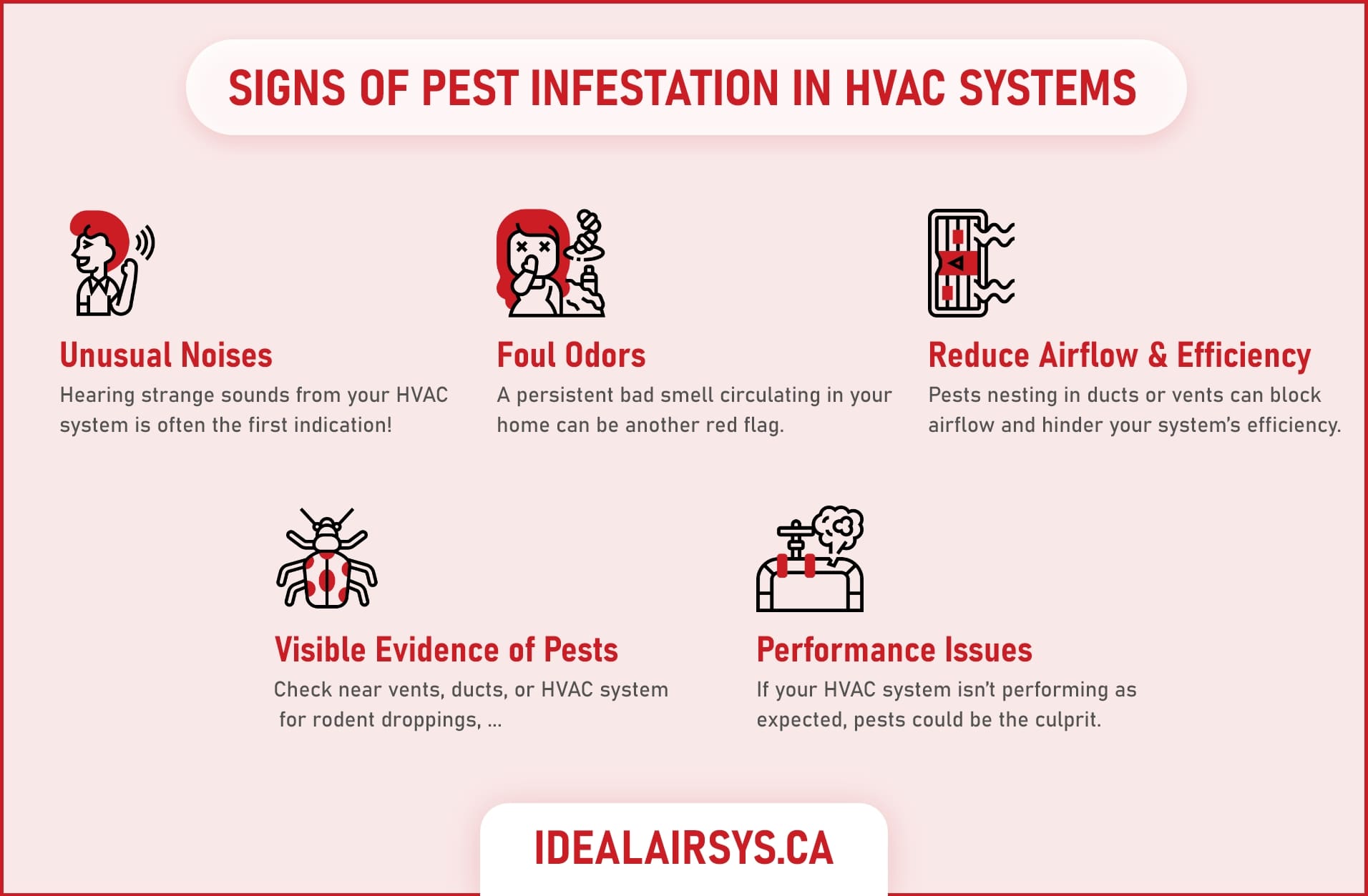
How Ideal Air Systems Can Help Detect and Prevent Pest Infestations
At Ideal Air Systems, we specialize in safeguarding your HVAC system from pests. Serving Toronto, Markham, Richmond Hill, Vaughan, and Newmarket, our expert technicians provide thorough inspections and customized solutions to keep your home pest-free.
Why Choose Us? 😘
- Quick Response: We’ll address signs of pest infestations promptly to prevent further damage.
- Expert Maintenance: Routine servicing ensures your system stays in top shape and free from pests.
- Affordable Solutions: Get the peace of mind you deserve without breaking the bank.
If you’ve noticed any of these warning signs, don’t wait—contact Ideal Air Systems today for reliable, professional pest prevention and HVAC maintenance.
Stay proactive and protect your home from costly damage and health risks. Click here to schedule your inspection!
Why Preventing Pest Infestations Is Critical
Regular HVAC Maintenance Minimizes Risks
Routine inspections and cleaning are essential for keeping pests at bay. During professional maintenance visits, technicians can identify potential pest issues and address them before they escalate. This proactive approach not only prevents infestations but also ensures your HVAC system operates at peak efficiency.
The Financial Impact of Pest Damage
Pest infestations can lead to significant financial burdens. Chewed wiring and clogged ducts often require expensive repairs. Additionally, a compromised HVAC system tends to work harder, increasing energy consumption and driving up utility bills. Preventing pests is far more cost-effective than repairing pest-related damage.
Protect Your Health and Safety
Pests can pose numerous health risks. Rodents and insects carry diseases and allergens that can contaminate your indoor air. Additionally, damaged wiring caused by pests can create fire hazards. Taking steps to prevent infestations protects your family’s health and your home’s safety.
Expert Solutions to Prevent HVAC Pest Infestations
Top 4 Solutions for Canadian Homeowners
If you live in Canada, especially in Toronto, Newmarket, Markham, Richmond Hill, or Vaughan, safeguarding your HVAC system from pests is essential. Protecting your furnace, air conditioner, boiler, ducts, and gas pipes can prevent costly damages and ensure the efficiency of your home’s heating and cooling. Consider the following expert tips to maintain a pest-free HVAC system:
- Seal Entry Points and Air Ducts: Ensuring all gaps, cracks, and openings around your HVAC system are properly sealed with caulk or weather stripping is essential to keep pests at bay. Small openings can serve as doorways for insects, rodents, and other pests to enter your home. Sealing entry points is not just about pest prevention—it also enhances your home’s energy efficiency by reducing drafts and preventing heat or cool air from escaping. This proactive measure saves on energy costs while safeguarding your HVAC system and your family’s comfort.
- Install Mesh Screens on Vents: Adding fine mesh covers to exterior vents is a simple yet powerful defense against pests. Birds, rodents, and insects often use unprotected vents as entryways, leading to blockages and reduced HVAC performance. Mesh screens are designed to allow optimal airflow while keeping pests out. Additionally, these screens can prevent leaves, debris, and other obstructions from entering the system, ensuring smooth operation year-round and reducing the risk of costly maintenance.
- Maintain Clean Landscaping: Proper landscaping plays a crucial role in protecting your HVAC system from pests. Overgrown vegetation and debris piles near outdoor units provide ideal nesting and hiding spots for pests. Regularly trimming bushes, trees, and shrubs, and keeping at least a three-foot clearance around your units, minimizes these risks. Clean landscaping also improves airflow around the unit, preventing overheating and enhancing efficiency. Maintaining a tidy yard creates a less hospitable environment for pests while ensuring your HVAC system performs optimally.
- Reduce Moisture and Humidity: Damp environments are highly attractive to pests, including insects and rodents. By addressing moisture issues such as leaks or standing water around your HVAC system, you can deter pests from taking up residence. Installing dehumidifiers, fixing plumbing leaks, and ensuring proper drainage are effective ways to maintain a dry environment. Lower humidity levels not only help in pest prevention but also improve indoor air quality by reducing mold and mildew growth. This dual benefit protects both your HVAC system and your family’s health, making moisture control a critical component of pest prevention.
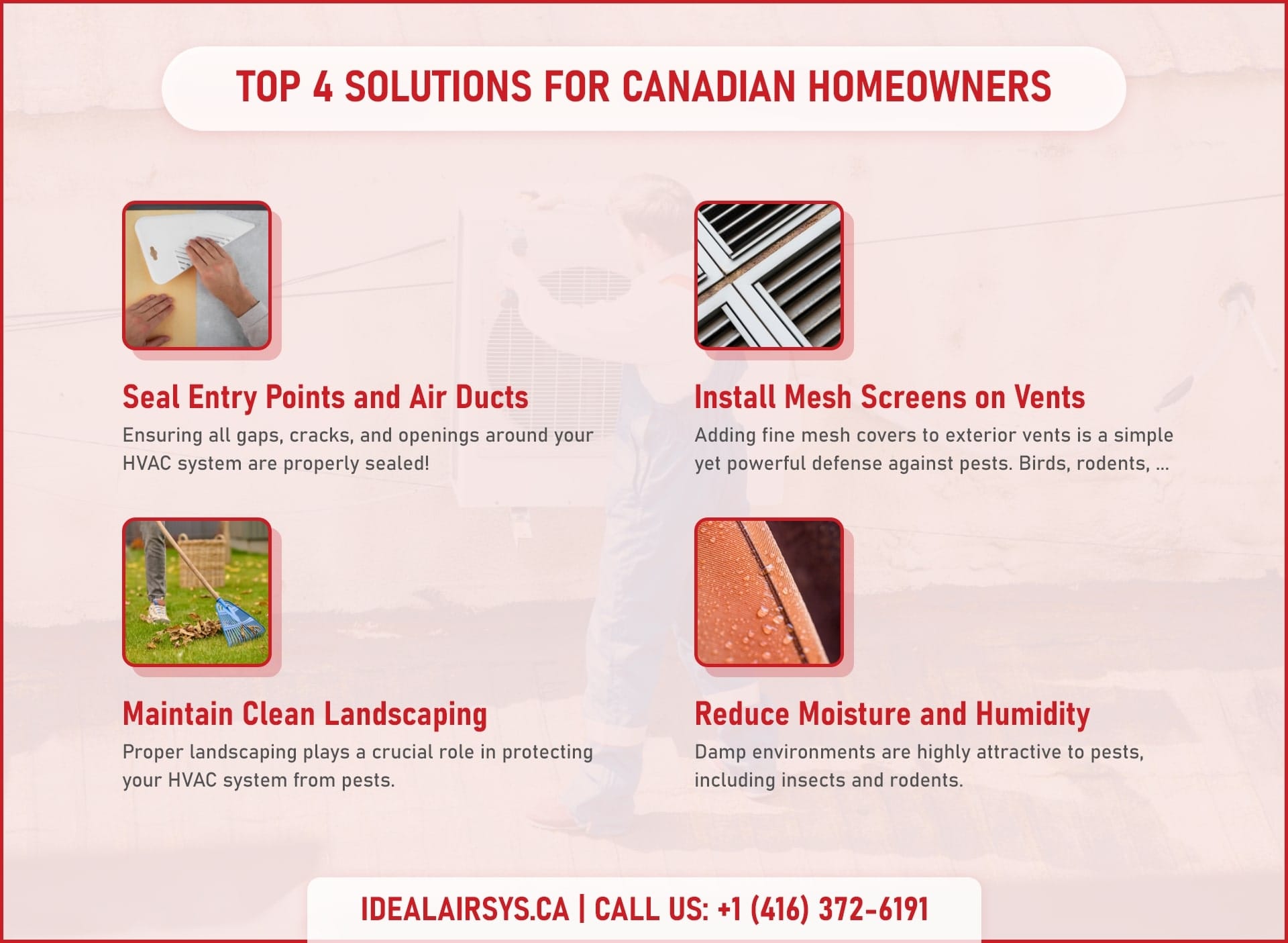
Additional Prevention Strategies
In addition to the top solutions, consider these strategies to further protect your HVAC system:
- Tighten HVAC Ductwork: Repair loose or damaged duct connections to block pest entry.
- Clean the HVAC System Regularly: Replace filters, clean ducts, and remove debris to eliminate potential pest attractants.
- Address Standing Water: Ensure there is no water pooling around outdoor units or in condensate pans.
- Secure Trash Cans: Keep outdoor trash bins tightly sealed to avoid attracting pests near your home.
- Use Natural Repellents: Place non-toxic deterrents like peppermint oil or cedar blocks around HVAC components to discourage pests.
- Schedule Routine Pest Control: Professional pest control services provide an added layer of protection against infestations.
Embrace Technology for Pest Prevention
Modern advancements such as pest-resistant duct materials, smart vent screens, and IoT-enabled monitoring devices offer innovative ways to safeguard your HVAC system. These tools provide long-term solutions and early warnings of potential infestations.
DIY vs. Professional Help: Choosing the Right Approach
DIY Pest Prevention
For minor issues, DIY pest prevention can be a practical solution. Sealing entry points, cleaning ducts, and using natural repellents are straightforward measures homeowners can take. However, DIY efforts may not address deep-seated infestations or prevent recurring problems.
When to Call Professionals
For complex or recurring pest issues, professional help is invaluable. Experienced technicians can thoroughly inspect your HVAC system, identify hidden infestations, and implement advanced pest control methods. Investing in professional services ensures long-term prevention and system integrity. If you need professional pest prevention system, contact our support team now. We will do our best try for you.
Checklist: Keep Your HVAC System Pest-Free
Follow this simple checklist to protect your HVAC system from pests and ensure a comfortable, efficient home environment:
1. Inspect and Maintain Regularly
- Schedule Professional Inspections: Have your system checked twice a year to detect and address pest issues early.
- Check for Gaps and Loose Ducts: Inspect ducts and vents for cracks, holes, or loose connections.
2. Seal and Protect
- Seal Gaps: Use caulk or foam to close gaps around vents, windows, and HVAC components.
- Install Mesh Screens: Protect exterior vents with fine mesh screens to keep pests out while maintaining airflow.
3. Clean and Manage Moisture
- Replace Filters: Regularly change air filters to improve air quality and deter pests.
- Fix Leaks: Address plumbing issues and standing water around HVAC units to reduce moisture.
4. Maintain Landscaping
- Trim Vegetation: Keep bushes, trees, and shrubs at least three feet away from outdoor units.
- Clear Debris: Remove leaves, nests, and clutter around your HVAC system to eliminate nesting spots.
5. Use Pest Control Measures
- Non-Toxic Repellents: Place natural deterrents like peppermint oil near HVAC components.
- Secure Trash Bins: Keep outdoor garbage bins sealed to avoid attracting pests close to your home.
6. Upgrade for Long-Term Protection
- Invest in Technology: Consider pest-resistant duct materials and smart vent screens for advanced protection.
- Add Weather-Resistant Covers: Protect outdoor units during winter to prevent snow and pests from causing damage.
Take Action Today!
A pest-free HVAC system means better comfort, lower costs, and peace of mind. For expert inspections and tailored pest prevention solutions in Toronto, Markham, Richmond Hill, Vaughan, or Newmarket, contact Ideal Air Systems now! ✋❤️
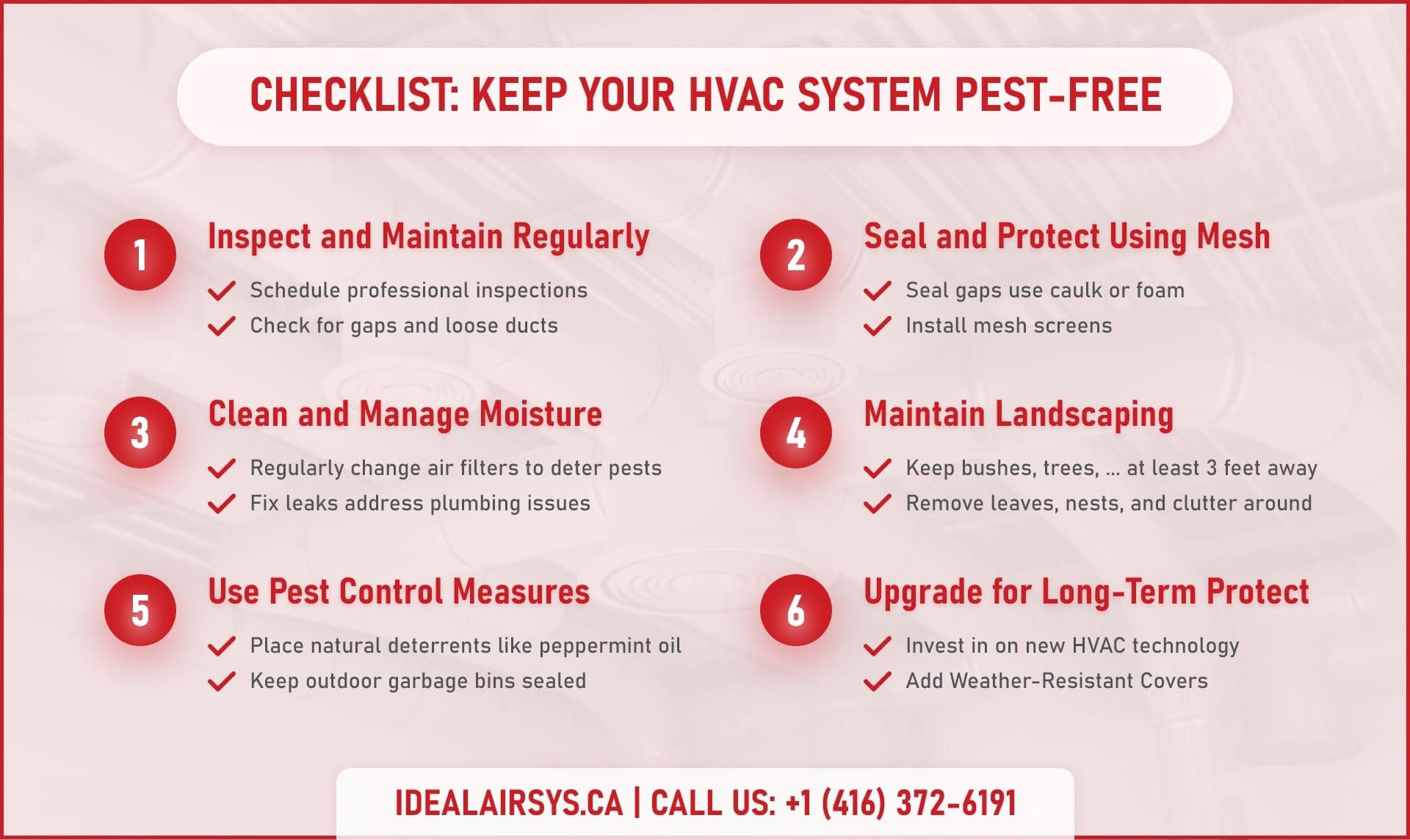
Special Tips for Canadian Homes
Ontario’s long winters and snow-covered outdoor units require extra care to ensure HVAC systems remain operational and pest-free. Protecting outdoor components with weather-resistant covers is essential to shield them from harsh weather conditions. Proper insulation not only improves system efficiency but also deters pests seeking warmth. Additionally, regularly clearing snow, ice, and debris from around the units is crucial. This not only prevents blockages and system strain but also eliminates potential nesting sites for rodents and other pests. Taking these steps ensures the longevity of your HVAC system while maintaining a pest-free environment during the colder months.
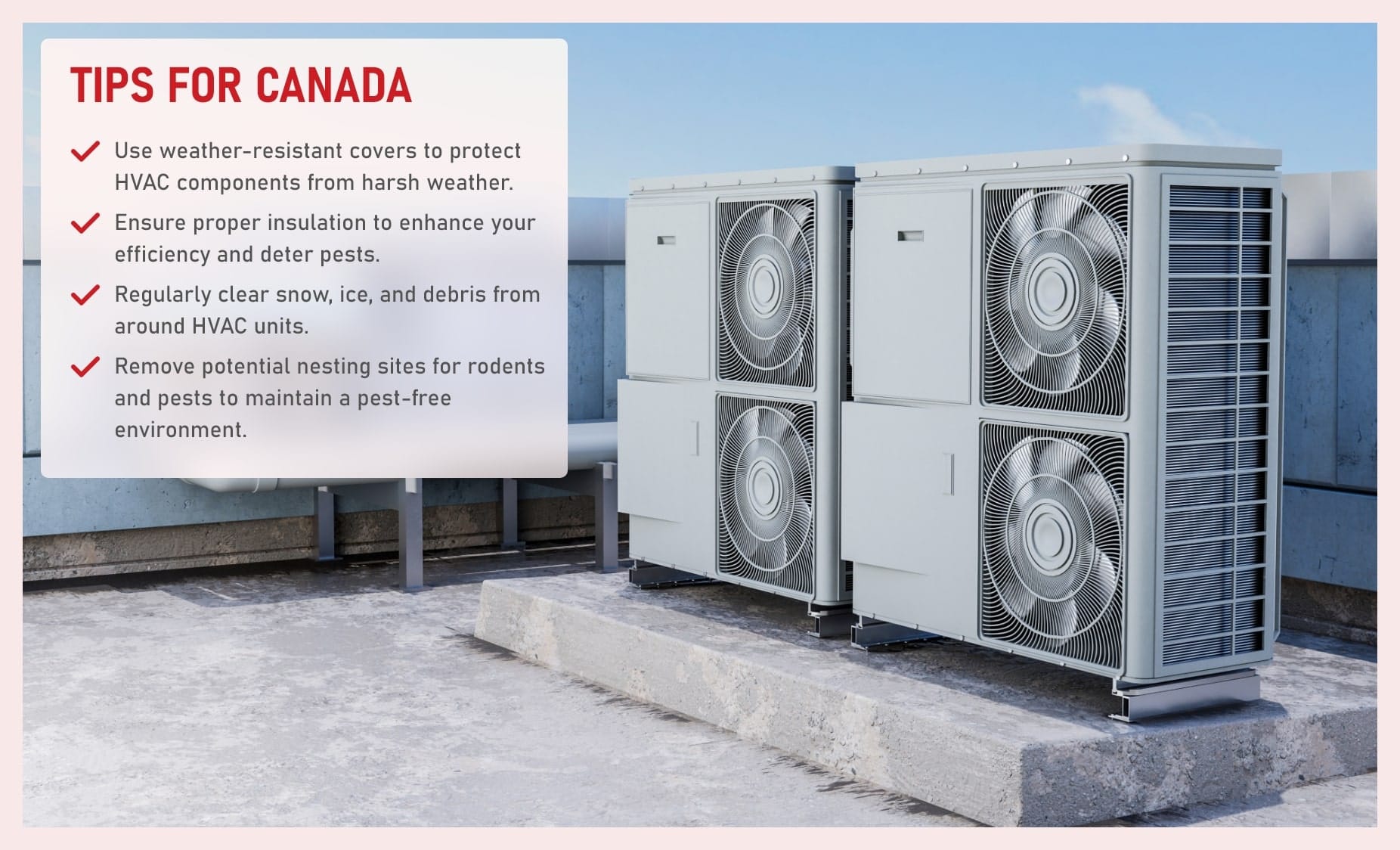
Frequently Asked Questions
- How do pests enter HVAC systems? Pests often gain access through unsealed ducts, vents, and gaps around the unit or home’s exterior.
- What are the signs of a pest infestation? Look for unusual noises, foul odors, and visible debris or nests near vents.
- Can pests affect indoor air quality? Yes, pests can introduce allergens, pathogens, and contaminants into your home’s air.
- How often should I inspect my system? It’s advisable to inspect your system at least twice a year, preferably before the heating and cooling seasons.
- What steps can I take to prevent pests from entering my HVAC system? Seal all entry points, maintain cleanliness around the unit, and schedule regular professional maintenance.
- Are there specific pests that are more likely to infest HVAC systems? Common culprits include rodents, insects like ants and cockroaches, and occasionally birds or bats.
- Can pest infestations damage my HVAC system? Yes, pests can chew through wiring, clog ducts, and cause other damages leading to system inefficiencies or failures.
- Is professional pest control necessary for HVAC systems? While some preventive measures can be DIY, professional inspections ensure thorough pest control and system integrity.
- How does landscaping affect pest presence around my HVAC unit? Overgrown vegetation can harbor pests; maintaining a clear area around the unit helps deter infestations.
- What should I do if I discover pests in my HVAC system? Immediately contact a licensed pest control professional to assess and address the infestation safely.
Do You Need to Protect Your Home from Pests in Toronto? Call Us Now!
Don’t wait until pests compromise your HVAC system! Contact Ideal Air Systems for expert HVAC inspections, pest prevention, and maintenance services in Toronto, Markham, Richmond Hill, Vaughan, and Newmarket. Our team is dedicated to keeping your home comfortable and pest-free year-round. Click here to learn more about our services.

Conclusion: Ensure Comfort and Safety Year-Round
Proactive pest prevention is essential for maintaining a comfortable and healthy home environment. By sealing entry points, cleaning your HVAC system, and scheduling regular maintenance, you can keep pests out and enjoy peace of mind.
Trust Ideal Air Systems to safeguard your home with our dependable HVAC services. Reach out today to ensure your HVAC system remains pest-free and efficient!

